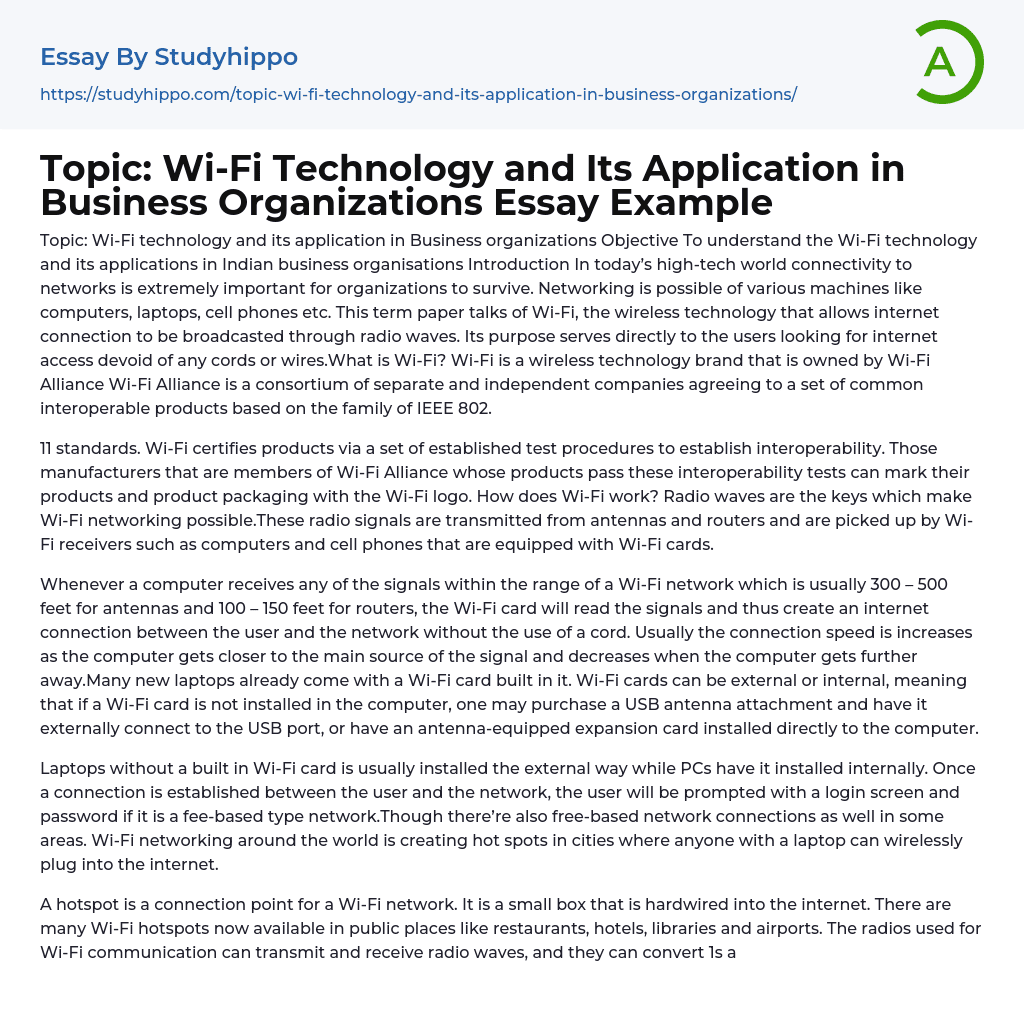

Topic: Wi-Fi Technology and Its Application in Business Organizations Essay Example
The article highlights the significance of Wi-Fi technology in present-day Indian business organizations. Its primary aim is to enhance comprehension of Wi-Fi technology and its integration into Indian businesses. In today's era of technological advancements, network connectivity through diverse devices like computers, laptops, and cell phones plays a crucial role in organizational survival. The paper elucidates how Wi-Fi works by facilitating internet connection via radio waves sans cords or cables. Additionally, it mentions that Wi-Fi is a wireless brand owned by the Wi-Fi Alliance that produces compatible products founded on IEEE 802 family standards.
The procedure for Wi-Fi certification involves the assessment of interoperability based on 11 standards and established protocols. Products that successfully complete the testing process are granted permission to display the Wi-Fi logo on their packaging. Wi-Fi technolog
...y functions by transmitting radio waves from antennas and routers to devices fitted with Wi-Fi cards, such as cell phones and computers.
Wi-Fi signals can travel up to 300-500 feet for antennas and 100-150 feet for routers. By catching these signals, computers can connect wirelessly to the internet without cords. The connection speed is faster when the computer is closer to the signal source, while moving away may decrease it. Laptops come with built-in Wi-Fi cards or users may opt for external options such as USB antenna attachments connected via USB ports or antenna-equipped expansion cards installed directly onto their computers.
For laptops that do not have Wi-Fi cards, external installation is the norm. On the other hand, internal installation is prevalent for PCs. To connect to fee-based networks, a login screen and password are necessary while free networks may be available in specific places. Wireless hot spot
are emerging worldwide in urban areas to offer wireless internet access to laptop users.
A wireless access point for internet connection is established by a compact tool known as a Wi-Fi hotspot. It can be found in communal places such as hotels, libraries, airports, and restaurants and connects to the web through a wired connection. The radios utilized for Wi-Fi communication are capable of bidirectional transmission of radio waves and converting digital data into radio waves and vice versa.
There are two primary differences between Wi-Fi radios and other types of radios. Firstly, Wi-Fi radios operate at higher frequencies (2.4GHz or 5GHz), enabling the transmission of more significant data than those used for cell phones, walkie-talkies, and televisions. Secondly, Wi-Fi radios adhere to the 802.11 networking standards.
Wi-Fi technology utilizes three frequency bands for transmission and can quickly switch between them through frequency hopping. This feature minimizes interference and enables multiple devices with wireless adapters to simultaneously share a single wireless connection, providing a convenient and inconspicuous connection that is reasonably reliable. Nevertheless, if the router experiences technical difficulties or numerous users attempt to use high-bandwidth applications at once, it may lead to interference and disconnection.
The 802.11 standard has been released by the IEEE in a chronological sequence, consisting of three versions: 802.11b, 802.11a, and 802.11g.
The table below displays the primary differences between each standard, including their respective and contents:
| Standard | 802.11b | 802.11a | 802.11g | |
|---|---|---|---|---|
|
Frequency Band |
2.4 GHz |
5 GHz |
2.4 GHz |
|
|
Data transfer rate |
up to 11 Mbps |
< p >up to 54 Mbps | ||
| < p >Channels | < p > up to 14 non-overlapping channels < / P > | up to 14 non-overlapping channels | ||
| < p >Modulation scheme
DSSS (Direct Sequence Spread Spectrum) OFDM (Orthogonal Frequency Division Multiplexing) DSSS and OFDM |



